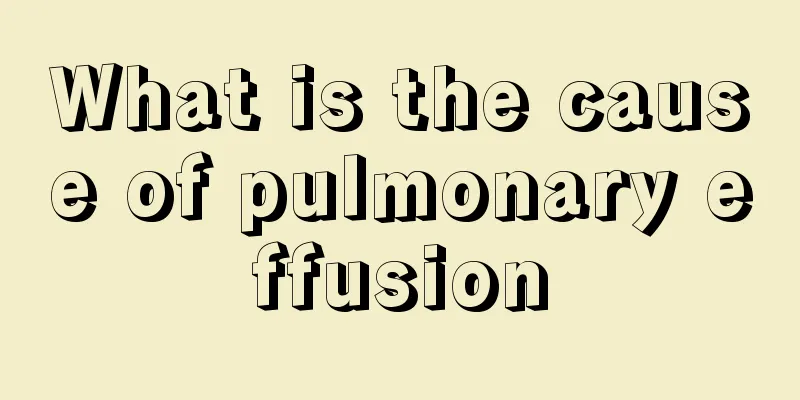What is the cause of pulmonary effusion

|
Pulmonary effusion is a condition in which there is a large amount of fluid in the lungs. There are two causes of pulmonary effusion: one is that the bronchial tubes are blocked, and the other is that the lungs are subjected to a certain amount of external pressure. The clinical manifestations of pulmonary effusion depend on the severity of the patient's condition, mainly including some breathing difficulties, lateral chest deformation, etc. Some patients with pulmonary effusion have no obvious symptoms. However, once lung effusion is discovered, timely treatment is required, otherwise it will have a great impact on the patient's respiratory function and cause great pain to the patient. Next, I will give you a detailed introduction to the causes, clinical manifestations and treatments of pulmonary effusion! 1. Causes of pulmonary effusion Pulmonary effusion indicates that there are obvious lesions in the lungs. If the pulmonary effusion is not treated, it will affect the patient's respiratory function. There are two causes of right-sided atelectasis, which can be caused by bronchial obstruction (including internal or external factors) or external pressure on the lungs. The most common causes of intrinsic bronchial obstruction are aspirated foreign bodies, thick mucus, inflammatory exudates, bronchial tumors, bronchial granulation tissue, or inflammatory bronchial stenosis. Extrinsic bronchial obstruction can be caused by lymphadenopathy (including tuberculosis, tumors, and sarcoidosis), peribronchial tumors, aortic aneurysms, heart enlargement (such as left atrial enlargement), and pericardial effusion. Lung collapse is caused by external pressure on the lungs, which may be caused by a large amount of pleural effusion or pneumothorax, intrathoracic tumors, chest depression (congenital, traumatic or postoperative) and diaphragm rise. 2. Clinical manifestations of pulmonary effusion The clinical manifestations of pulmonary effusion vary greatly and are closely related to the extent of atelectasis and the cause of it. Unilateral atelectasis is often accompanied by obvious dyspnea, and physical examination often reveals changes such as deformation of the affected side of the chest, disappearance of breath sounds, solid percussion sounds, and displacement of the trachea to the affected side. However, the symptoms of localized atelectasis may not be obvious, and the clinical signs are also atypical. Therefore, even if no lesions are found, examination and treatment should continue. Treatment of pulmonary effusion If the B-ultrasound shows that the amount of pleural effusion is large and easy to extract, please extract the effusion to temporarily relieve the symptoms. If the effusion is very small and there is no need to extract it, please continue with anti-infection treatment and actively control lung inflammation. If you do not want to undergo bronchoscopy, you can review the chest X-ray and lung CT scan while undergoing treatment, and compare the images to find out the cause and take appropriate treatment. |
<<: Does formaldehyde have a smell?
>>: Is it reliable to remove formaldehyde by air conditioning heating
Recommend
Will black wolfberry cause internal heat?
Wolfberry is a very common thing in daily life. W...
How to clean moldy clothes
There are more rainy seasons, and the weather bel...
What are the differences between exfoliating scrubs? Which one works better?
Scrub and exfoliator are two common exfoliating p...
Eating these can supplement collagen
The signs of aging are always reflected on the fa...
Symptoms of chin hyaluronic acid embolism
Nowadays in the beauty industry, when it comes to...
Why does the tooth still hurt after being repaired? 5 reasons to analyze
Filling a tooth is the most direct way to relieve...
How to confirm that the summer mat contains formaldehyde?
The weather is hot in summer. If you sleep direct...
What kind of health care should be taken after suffering from lung cancer
Among the many diseases of the lungs, lung cancer...
What are the pros and cons of stenting for cerebral infarction
After a disease like cerebral infarction occurs, ...
Why does my anus hurt when I defecate?
Pain in the anus may be caused by anal fissure. T...
What are the symptoms of old age?
Concussion is very common and usually occurs acut...
How to deal with jellyfish stings?
When the weather is hot, many people like to go t...
Natural way to dye grey hair black
There are many reasons for the appearance of gray...
What should I do if I feel anxious and can't sleep
When we feel anxious and can't sleep, we shou...
What fruit absorbs fat
Whether you are a man or a woman, you can eat mor...









